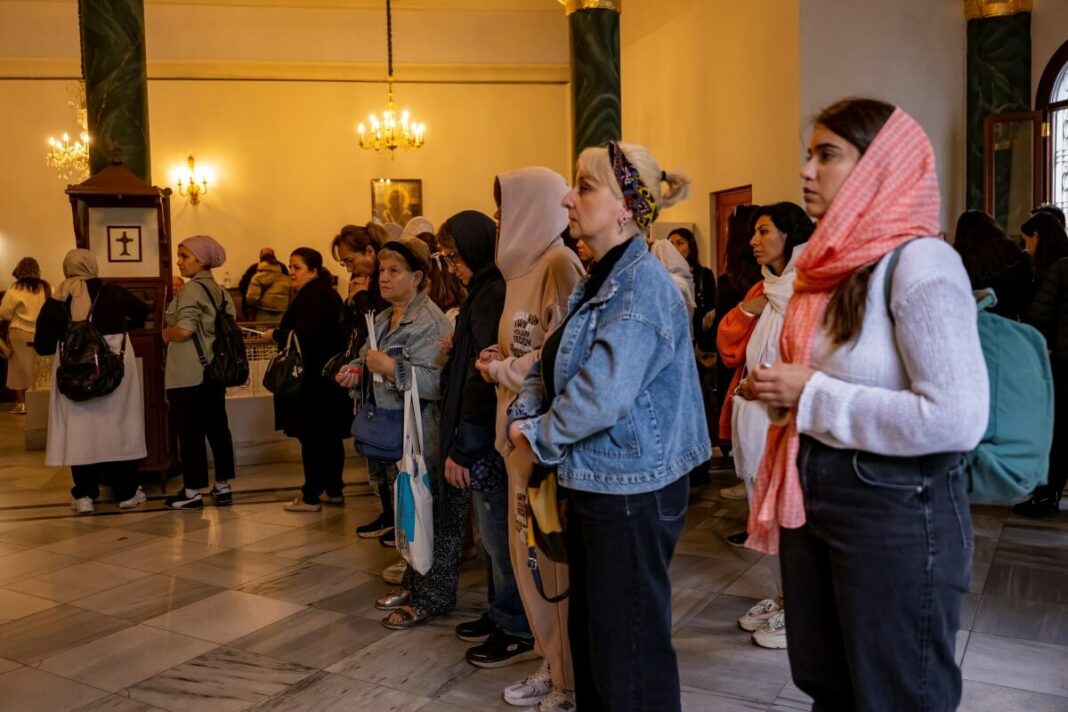The queue outside İstanbul’s Our Lady of Vefa church stretched more than 200 meters, made up of Christians and Muslims chatting animatedly as they waited to make a wish inside this Greek Orthodox sanctuary.
It was a scene that plays out on the first day of every month at this ancient house of worship hidden behind a high wall topped with a metal fence and known in Turkish as “the first-of-the-month church.”
“We came before with friends, and every one of our wishes came true!” said Emine Şanlı, a Muslim woman who believes she was cured of a problem with her hands after drinking water from a spring under the church that is blessed by a priest.
“But it’s the first time I’ve seen such a large crowd. Perhaps it’s because the economy is so bad,” said Şanlı, 58.
At the entrance, the visitors, mostly women, bought small keys and offerings, each symbolizing a different wish: health, inner peace, money, success, marriage, fertility and even “never-ending love.”
A Georgian tourist who also came last year walked alongside the queue handing out sweets to those in line — a Muslim tradition.
“When wishes are coming true … you have to come and give sweets to the people,” said 35-year-old Tamar Khurtsidze with a smile.
‘Different faiths, all God’s children’
For Aysun Zırhlı, 49, there is nothing strange in a Muslim making a wish at a church.
“We can all have different religions, but we’re all children of God,” she said while choosing a sweet.
Inside the church, each person adhered to their own religious practices, whether by crossing themselves like Christians or praying with their hands open like Muslims.
Descending steps into an underground chapel, a man bent to fill a bottle with holy water from a row of taps set in marble.
There, a sign encourages visitors to wash their hands and face, but not their feet — a common Muslim practice.
Father Hieronymos Sotirelis of the Ecumenical Patriarchate of Constantinople said the church’s appeal had “transcended religious boundaries.”
“The presence of pilgrims from different backgrounds serves to show that we can truly coexist despite, or even because of our cultural, linguistic, religious and ideological differences,” he told Agence France-Presse.
The large crowd surprised passers-by in a city where churches have often fallen into disuse or been converted into mosques, such as the illustrious Byzantine basilica Hagia Sophia in 2020 and the Holy Savior church in Chora earlier this year.
Although Christians were an important minority under the Ottoman Empire, today they represent an estimated 0.2 percent of Turkey’s 85-million-strong population — their numbers were depleted by the Armenian genocide, massacres of Assyrians and Black Sea Pontic Greeks, population exchanges and pogroms.
‘Good for religions to come together’
Our Lady of Vefa is an eloquent testimony to the multicultural past of İstanbul, former capital of the Roman Empire when it was known as Constantinople.
“This tradition of sharing a space is a long tradition that has stayed from empires, because the empires brought together so many different peoples,” said Karen Barkey, chair of sociology and religion at Bard College in New York.
She said there are many similar “shared sacred sites” around the Mediterranean.
Among them are churches, synagogues and Muslim sanctuaries that have “survived the kind of nationalism that wants to homogenize, that wants everybody in their own spaces.”
“Turkey is really not an exemplary case of religious coexistence anymore. It used to be in the Ottoman Empire, but today it’s not,” reflected Barkey, who was born in İstanbul but no longer lives there.
She put that down to the Turkish state’s desire to fill people’s minds with “this Sunni homogeneous ideology” to the detriment of both Christians and the country’s millions of Alevi Muslims, whose rites differ from orthodox Islam.
Not everyone buys into the idea of a homogenous religious identity.
“I’m a Muslim, but I believe in all religions, so I visit all places of worship,” said 50-year-old fashion designer Serkan Esen.
“Given the current state of the world, I think it’s good to come to places like this and see so many people and religions coming together.”



